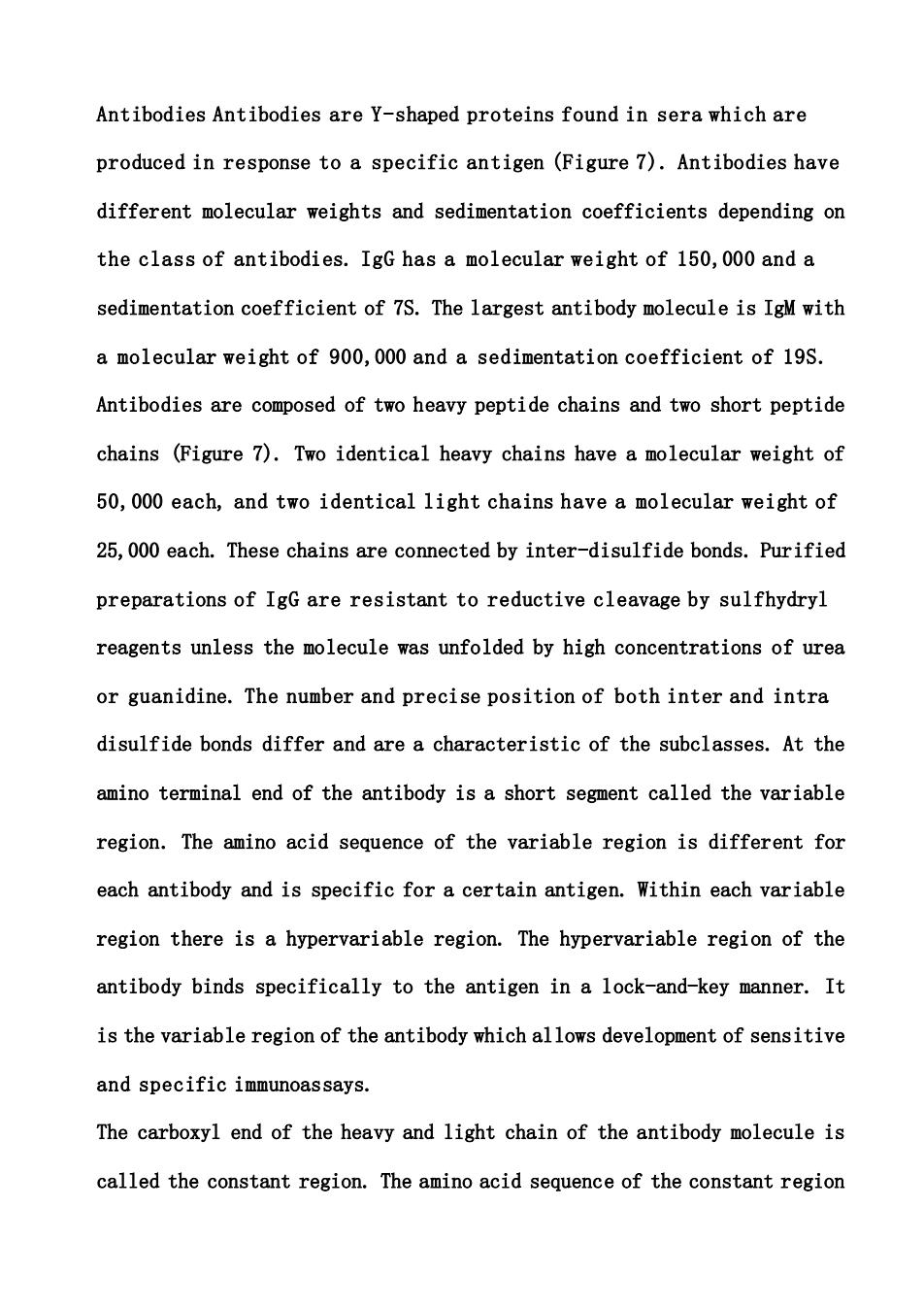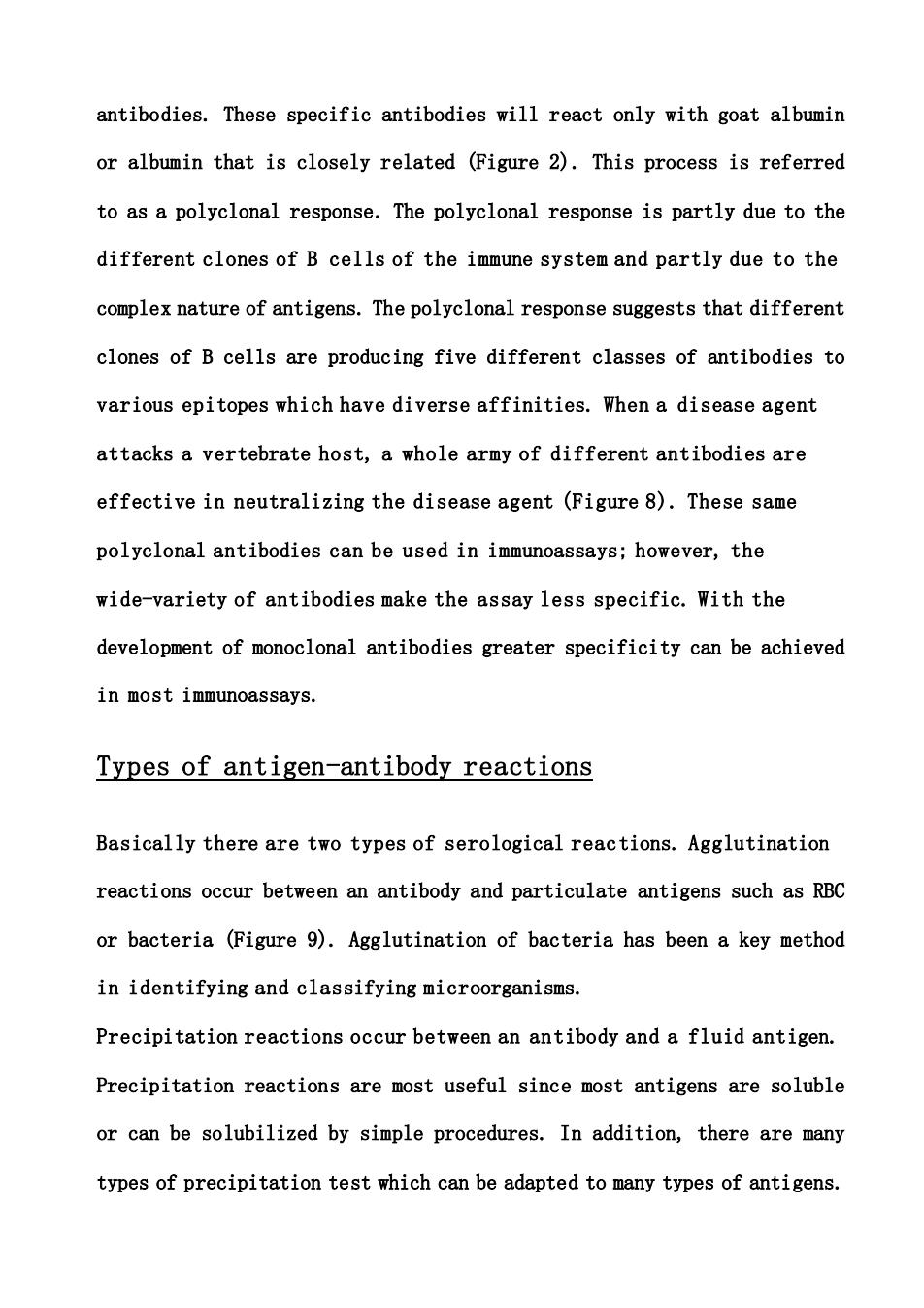
Antibodies Antibodies are Y-shaped proteins found in sera which are produced in response to a specific antigen(Figure 7).Antibodies have different molecular weights and sedimentation coefficients depending on the class of antibodies.IgG has a molecular weight of 150,000 and a sedimentation coefficient of 7S.The largest antibody molecule is IgM with a molecular weight of 900,000 and a sedimentation coefficient of 19S. Antibodies are composed of two heavy peptide chains and two short peptide chains (Figure 7).Two identical heavy chains have a molecular weight of 50,000 each,and two identical light chains have a molecular weight of 25,000 each.These chains are connected by inter-disulfide bonds.Purified preparations of IgG are resistant to reductive cleavage by sulfhydryl reagents unless the molecule was unfolded by high concentrations of urea or guanidine.The number and precise position of both inter and intra disulfide bonds differ and are a characteristic of the subclasses.At the amino terminal end of the antibody is a short segment called the variable region.The amino acid sequence of the variable region is different for each antibody and is specific for a certain antigen.Within each variable region there is a hypervariable region.The hypervariable region of the antibody binds specifically to the antigen in a lock-and-key manner.It is the variable region of the antibody which allows development of sensitive and specific immunoassays. The carboxyl end of the heavy and light chain of the antibody molecule is called the constant region.The amino acid sequence of the constant region
Antibodies Antibodies are Y-shaped proteins found in sera which are produced in response to a specific antigen (Figure 7). Antibodies have different molecular weights and sedimentation coefficients depending on the class of antibodies. IgG has a molecular weight of 150,000 and a sedimentation coefficient of 7S. The largest antibody molecule is IgM with a molecular weight of 900,000 and a sedimentation coefficient of 19S. Antibodies are composed of two heavy peptide chains and two short peptide chains (Figure 7). Two identical heavy chains have a molecular weight of 50,000 each, and two identical light chains have a molecular weight of 25,000 each. These chains are connected by inter-disulfide bonds. Purified preparations of IgG are resistant to reductive cleavage by sulfhydryl reagents unless the molecule was unfolded by high concentrations of urea or guanidine. The number and precise position of both inter and intra disulfide bonds differ and are a characteristic of the subclasses. At the amino terminal end of the antibody is a short segment called the variable region. The amino acid sequence of the variable region is different for each antibody and is specific for a certain antigen. Within each variable region there is a hypervariable region. The hypervariable region of the antibody binds specifically to the antigen in a lock-and-key manner. It is the variable region of the antibody which allows development of sensitive and specific immunoassays. The carboxyl end of the heavy and light chain of the antibody molecule is called the constant region. The amino acid sequence of the constant region

is similar to the sequence of antibody in the same class.The constant region is the part of the antibody that binds to mast cells,complement,and protein A.Protein A is a bacterial cell wall protein isolated from Staphylococcus aureus which binds to the Fc (Fragment-crystallizable)fragment of the antibody molecule.This protein can be used in affinity chromatography to purify antibodies. Papain digestion cleaves IgG molecules into two fragments which can be separated by carboxymethyl cellulose ion exchange chromatography.One fragment will crystallize spontaneously.This fragment is called Fe fragment (fragment-crystallizable)and is deficient in antigen-binding ability.The Fc fragment has a molecular weight of approximately 50,000 and a sedimentation coefficient of 3.5S.The Fc fragment is the constant region of the heavy chain with a COOH terminus end.The second fragment is fragment antigen-binding (Fab).The molecular weight and sedimentation coefficient for the Fab are similar to Fc fragments.An IgG molecule consists of 1 Fc and 2 Fab fragments.Each Fab fragment consists of the amino terminal half of the heavy and light chains.It was possible to predict the structure of IgG molecule with Papain (Fc and Fab)fragments and sulfhydryl reagents which split the IgG molecule into light and heavy chains Antibodies specifically combine with a small segment of the antigen called the antigenic determinant or epitope to form an antigen-antibody complex. The antigen-antibody reaction is characterized by specificity.If a mouse is injected with goat albumin,the mouse will produce antigoat albumin
is similar to the sequence of antibody in the same class. The constant region is the part of the antibody that binds to mast cells, complement, and protein A. Protein A is a bacterial cell wall protein isolated from Staphylococcus aureus which binds to the Fc (Fragment-crystallizable) fragment of the antibody molecule. This protein can be used in affinity chromatography to purify antibodies. Papain digestion cleaves IgG molecules into two fragments which can be separated by carboxymethyl cellulose ion exchange chromatography. One fragment will crystallize spontaneously. This fragment is called Fc fragment (fragment-crystallizable) and is deficient in antigen-binding ability. The Fc fragment has a molecular weight of approximately 50,000 and a sedimentation coefficient of 3.5S. The Fc fragment is the constant region of the heavy chain with a COOH terminus end. The second fragment is fragment antigen-binding (Fab). The molecular weight and sedimentation coefficient for the Fab are similar to Fc fragments. An IgG molecule consists of 1 Fc and 2 Fab fragments. Each Fab fragment consists of the amino terminal half of the heavy and light chains. It was possible to predict the structure of IgG molecule with Papain (Fc and Fab) fragments and sulfhydryl reagents which split the IgG molecule into light and heavy chains. Antibodies specifically combine with a small segment of the antigen called the antigenic determinant or epitope to form an antigen-antibody complex. The antigen-antibody reaction is characterized by specificity. If a mouse is injected with goat albumin, the mouse will produce antigoat albumin

antibodies.These specific antibodies will react only with goat albumin or albumin that is closely related (Figure 2).This process is referred to as a polyclonal response.The polyclonal response is partly due to the different clones of B cells of the immune system and partly due to the complex nature of antigens.The polyclonal response suggests that different clones of B cells are producing five different classes of antibodies to various epitopes which have diverse affinities.When a disease agent attacks a vertebrate host,a whole army of different antibodies are effective in neutralizing the disease agent (Figure 8).These same polyclonal antibodies can be used in immunoassays;however,the wide-variety of antibodies make the assay less specific.With the development of monoclonal antibodies greater specificity can be achieved in most immunoassays. Types of antigen-antibody reactions Basically there are two types of serological reactions.Agglutination reactions occur between an antibody and particulate antigens such as RBC or bacteria (Figure 9).Agglutination of bacteria has been a key method in identifying and classifying microorganisms. Precipitation reactions occur between an antibody and a fluid antigen. Precipitation reactions are most useful since most antigens are soluble or can be solubilized by simple procedures.In addition,there are many types of precipitation test which can be adapted to many types of antigens
antibodies. These specific antibodies will react only with goat albumin or albumin that is closely related (Figure 2). This process is referred to as a polyclonal response. The polyclonal response is partly due to the different clones of B cells of the immune system and partly due to the complex nature of antigens. The polyclonal response suggests that different clones of B cells are producing five different classes of antibodies to various epitopes which have diverse affinities. When a disease agent attacks a vertebrate host, a whole army of different antibodies are effective in neutralizing the disease agent (Figure 8). These same polyclonal antibodies can be used in immunoassays; however, the wide-variety of antibodies make the assay less specific. With the development of monoclonal antibodies greater specificity can be achieved in most immunoassays. Types of antigen-antibody reactions Basically there are two types of serological reactions. Agglutination reactions occur between an antibody and particulate antigens such as RBC or bacteria (Figure 9). Agglutination of bacteria has been a key method in identifying and classifying microorganisms. Precipitation reactions occur between an antibody and a fluid antigen. Precipitation reactions are most useful since most antigens are soluble or can be solubilized by simple procedures. In addition, there are many types of precipitation test which can be adapted to many types of antigens

In many cases nonprecipitating antigen-antibody reactions can be detected indirectly with other antibodies,isotopes,or enzymes. The antigen-antibody reaction takes place in two phases Figure 10.In the first phase,combination of the reactants occurs:this is followed by second phase,an aggregation (precipitation or agglutination).The first phase stages take place almost instantaneously.In the second stage of the reaction,aggregation of the antigen-antibody complex occurs.This phase does not occur when monovalent antibodies or haptens are involved in the reaction.The lattice hypothesis,which is based on multivalent antigens and bivalent antibodies,is useful in explaining the zone phenomena.At the equivalence point all of the antigen and all the antibody molecules are consumed in the lattice formation.With multivalent antigen where Figure 8 Figure 9 the antigenic site is not repeated,it requires two different antibodies directed at different antigenic sites to form a lattice.When there is an excess of antibody (prozone),aggregation is not observed phases Figure 11.Each antigen is surround by antibodies.Essentially the reverse situation occurs in postzone,where too little antibody is present to produce an aggregation each antibody molecule only binds to one antigen. The size of the aggregation complex increases as the optimal ratio of antigen to antibody is achieved.This is referred to as the equivalence zone
In many cases nonprecipitating antigen-antibody reactions can be detected indirectly with other antibodies, isotopes, or enzymes. The antigen-antibody reaction takes place in two phases Figure 10. In the first phase, combination of the reactants occurs; this is followed by second phase, an aggregation (precipitation or agglutination). The first phase stages take place almost instantaneously. In the second stage of the reaction, aggregation of the antigen-antibody complex occurs. This phase does not occur when monovalent antibodies or haptens are involved in the reaction. The lattice hypothesis, which is based on multivalent antigens and bivalent antibodies, is useful in explaining the zone phenomena. At the equivalence point all of the antigen and all the antibody molecules are consumed in the lattice formation. With multivalent antigen where Figure 8 Figure 9 the antigenic site is not repeated, it requires two different antibodies directed at different antigenic sites to form a lattice. When there is an excess of antibody (prozone), aggregation is not observed phases Figure 11. Each antigen is surround by antibodies. Essentially the reverse situation occurs in postzone, where too little antibody is present to produce an aggregation each antibody molecule only binds to one antigen. The size of the aggregation complex increases as the optimal ratio of antigen to antibody is achieved. This is referred to as the equivalence zone